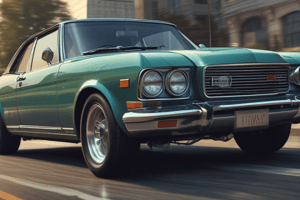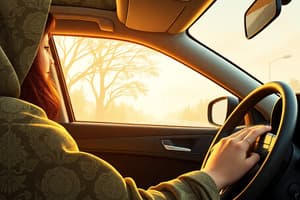Podcast
Questions and Answers
Explain how and why the key is held in the hand while approaching the car.
Explain how and why the key is held in the hand while approaching the car.
Held with the key pointed out, to protect against carjackers and avoid having to search through your purse.
Why is it a good practice to have headlights on during the day?
Why is it a good practice to have headlights on during the day?
Because it shows other drivers even if they aren't making a conscious effort to see you, seen 9/10 of a mile sooner.
Where does one position head restraint in relationship to one's head? Why?
Where does one position head restraint in relationship to one's head? Why?
Directly behind the head (ear level) to provide support, especially in an accident.
What are the benefits a driver and passenger receive by wearing seat belts?
What are the benefits a driver and passenger receive by wearing seat belts?
Explain how to make a smooth stop.
Explain how to make a smooth stop.
How should you hold your hands on the steering wheel while driving straight? Why?
How should you hold your hands on the steering wheel while driving straight? Why?
Explain how to select a target and aim the vehicle accurately toward it.
Explain how to select a target and aim the vehicle accurately toward it.
Explain the use of central vision and fringe vision when targeting.
Explain the use of central vision and fringe vision when targeting.
What does it mean to 'turn head before steering'? Why is it used?
What does it mean to 'turn head before steering'? Why is it used?
What is the 'transition peg' for making a right turn? A left turn? Explain how they are used.
What is the 'transition peg' for making a right turn? A left turn? Explain how they are used.
How much of a line-of-vision blind area do you have to the front of the car?
How much of a line-of-vision blind area do you have to the front of the car?
What is the standard reference point for positioning a vehicle 3-6 inches away from a line on the right?
What is the standard reference point for positioning a vehicle 3-6 inches away from a line on the right?
What is the standard reference point for positioning a vehicle 3 feet away from a line on the right?
What is the standard reference point for positioning a vehicle 3 feet away from a line on the right?
What is the standard reference point for positioning a vehicle 3-6 inches away from a line on the left?
What is the standard reference point for positioning a vehicle 3-6 inches away from a line on the left?
What does it mean to 'look to target area' when you are making a turn?
What does it mean to 'look to target area' when you are making a turn?
What does the 'oil pressure light' warn you about?
What does the 'oil pressure light' warn you about?
What does the 'brake light' warn you about?
What does the 'brake light' warn you about?
What does the odometer tell you?
What does the odometer tell you?
Explain the significance of a broken yellow line.
Explain the significance of a broken yellow line.
When entering a roadway from an alley, private road, driveway, or other places not controlled by signal lights, you are required to stop.
When entering a roadway from an alley, private road, driveway, or other places not controlled by signal lights, you are required to stop.
When making a left turn at an intersection or into an alley, private road, driveway, or any other place, you must yield right of way to...
When making a left turn at an intersection or into an alley, private road, driveway, or any other place, you must yield right of way to...
If you are the driver on a road that ends in a 'T' intersection with no signs or signals, you must yield to...
If you are the driver on a road that ends in a 'T' intersection with no signs or signals, you must yield to...
What is the speed limit when driving in alleys?
What is the speed limit when driving in alleys?
What is the speed limit in any business district?
What is the speed limit in any business district?
What is the speed limit in any residential district or public park?
What is the speed limit in any residential district or public park?
How does the lane position of others send communications?
How does the lane position of others send communications?
Flashcards are hidden until you start studying
Study Notes
Key Details on Car Approach and Safety
- Hold the key pointed out while approaching the car to deter carjackers and avoid rummaging through bags.
- Headlights should be on during the day to enhance visibility, potentially seen 9/10 of a mile sooner by other drivers.
Vehicle Positioning and Controls
- Position head restraints directly behind the head, at ear level, to provide support in the event of an accident.
- Seat belts protect drivers and passengers from being ejected forward during a collision.
Stopping and Steering Techniques
- For a smooth stop, release pressure on the brake 1-2 seconds before coming to a complete stop.
- Hold the steering wheel at the 9 and 3 positions, with thumbs on top, to minimize the risk of hand injury from airbag deployment.
Targeting and Vision Use
- Select a target above the 12 o'clock position on the steering wheel for accurate vehicle aiming.
- Utilize central and fringe vision to navigate effectively and make necessary adjustments for surrounding traffic.
Head Movement and Turn Preparation
- "Turn head before steering" means to look in the direction of travel to anticipate movement ahead of the vehicle.
- Transition pegs:
- Right turn: alignment of vision and rearview mirror with target area.
- Left turn: alignment of vision with the driver's side corner post towards the target area, requiring a head look before steering.
Vehicle Awareness and Reference Points
- Maintain a line-of-vision blind area of one car length in front of the vehicle.
- Standard reference points for positioning near lines:
- 3-6 inches from right line: center of hood.
- 3 feet from right line: middle of the right half of the hood.
- 3-6 inches from the left line: approximately 1 foot inside the left corner of the hood.
Turn Execution and Anticipation
- "Look to target area" before making turns to identify potential hazards and execute turns safely.
Dashboard Indicators
- The oil pressure light indicates oil is not circulating properly.
- Brake light signals that the parking brake might be engaged or there is a braking issue.
Mileage and Driving Regulations
- The odometer records total miles driven since the vehicle was new.
- A broken yellow line represents traffic in opposite directions with passing permitted.
Right of Way and Road Rules
- When entering from a non-signaled area, stop before reaching the sidewalk.
- When making left turns, yield to all traffic, pedestrians, and bicyclists.
- At a "T" intersection without signs, yield to the vehicle on the through street.
Speed Limits
- Alleys: speed limit is 15 mph.
- Business districts: speed limit is 20 mph.
- Residential districts and public parks: speed limit is 25 mph.
Communication through Lane Positions
- Lane positions convey intentions, indicating whether the driver intends to go straight or turn.
Studying That Suits You
Use AI to generate personalized quizzes and flashcards to suit your learning preferences.




